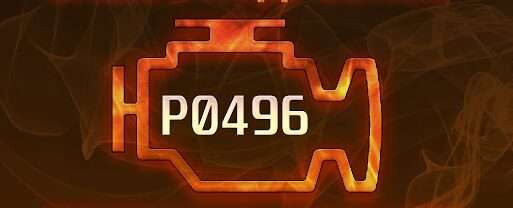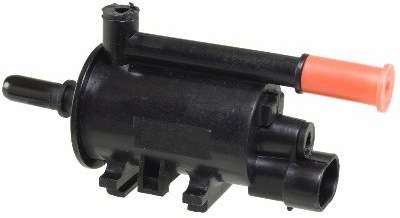
P0496 Evaporative Emission System - High Purge Flow
Content
P0496 – OBD-II Trouble Code Technical Description
The trouble code indicates that there is a problem with the purge flow in the evaporative emission system.
What does the fault code mean P0496?
Trouble code P0496 indicates a problem with the purge flow in the evaporative emission system. This means that an excessive amount of vacuum is being supplied to the evaporative emission system, which can lead to high fuel consumption during purge. If too much vacuum pressure builds up in the evaporative emission system, code P0496 will appear.

Possible reasons
Some possible reasons for the P0496 trouble code:
- Defective evaporative evacuation valve (EVAP).
- Leak in the fuel vapor recovery system.
- Malfunction of the vacuum unit or vacuum sensor.
- Incorrectly installed or damaged gas tank.
- Problems with the electrical components of the evaporative emission system.
- Incorrect operation of the pressure sensor in the fuel vapor recovery system.
- Incorrectly installed or damaged fuel tank.
What are the symptoms of a fault code? P0496?
Symptoms for DTC P0496 may vary depending on the specific cause and condition of the vehicle:
- The Check Engine light on the instrument panel comes on.
- Unusual fuel odors in or around the vehicle.
- Poor engine operation, including rough idling or loss of power.
- Increased fuel consumption.
- Artificial or unexplained sounds coming from the fuel tank or evaporative system area.
- Loss of fuel pressure.
- Deterioration in engine performance.
However, it is worth noting that these symptoms can also indicate other problems with the car, so it is recommended to carry out diagnostics to pinpoint the cause.
How to diagnose a fault code P0496?
To diagnose DTC P0496, the following steps are recommended:
- Check the Check Engine Light: Make sure the Check Engine light actually comes on. Use an OBD-II scanner to read the trouble code and get more information.
- Check fuel level: Make sure the fuel level in the tank is at the recommended level. Low fuel level can cause insufficient pressure in the evaporative emission system.
- Visual inspection: Inspect the fuel tank, fuel lines and connections for leaks or damage.
- Check the evaporative control valve (CCV): Check the condition of the fuel vapor control valve for leaks or damage. Make sure it closes properly and opens when needed.
- Check the fuel leak detector (EVAP) system: Check the fuel leak detector system components such as pressure sensors, valves and sealing elements for damage or leaks.
- Diagnostics using an OBD-II scanner: Use an OBD-II scanner to read additional data such as evaporative emission system performance and system pressure.
- Check electrical connections: Check the electrical connections and wires associated with the evaporative emission system for damage or oxidation.
- Check the sensors: Check the operation of sensors associated with the evaporative emission system, such as pressure sensor, temperature sensor and others, for damage or malfunction.
- Perform vacuum tests: Perform vacuum tests to ensure proper operation of the vacuum control system.
If there is a malfunction or uncertainty about diagnostics, it is recommended that you contact a qualified auto mechanic or service center for further diagnosis and repair.
Diagnostic errors
When diagnosing DTC P0496, the following errors may occur:
- Insufficient testing of the evaporative vapor recovery (EVAP) system: If diagnostics are limited to only reading the fault code, without further checking all EVAP system components, factors that could cause the fault may be missed.
- Incorrect interpretation of OBD-II scanner data: Some parameters provided by the OBD-II scanner may be misinterpreted. This can lead to misdiagnosis and replacement of unnecessary parts.
- Ignoring physical verification of componentsNote: Relying solely on OBD-II scanner data without physically checking EVAP system components may result in missing leaks or damage that may not be visible on the scanner.
- Neglecting electrical connections: Improperly checking or ignoring the condition of electrical connections and wires associated with the EVAP system may cause problems related to poor contact or short circuits to be missed.
- OBD-II scanner malfunction: In rare cases, misinterpretation of a trouble code may be due to a problem with the OBD-II scanner itself or its software.
To prevent these errors, it is recommended to use a comprehensive diagnostic approach, including physically checking components, analyzing OBD-II scanner data, checking electrical connections and wires, and calling a professional if necessary.
How serious is the fault code? P0496?
Trouble code P0496, which indicates a purge flow problem in the evaporative emission control (EVAP) system, is usually not critical or extremely serious. However, ignoring it can lead to ineffective operation of the fuel vapor recovery system, which in turn can lead to a deterioration in the environmental performance of the vehicle and increased emissions of harmful substances into the atmosphere.
Although the immediate impact on vehicle performance and safety is usually minimal, it is recommended that the problem be addressed as soon as possible to avoid additional problems with the evaporative emission control system and possible damage to other vehicle components. In addition, an EVAP problem could cause the vehicle to fail the emission test in some regions, which could result in fines or the vehicle being temporarily unusable on the road.
What repairs will resolve the P0496 code?
Troubleshooting DTC P0496 may include the following repair steps:
- Check and replace the fuel drop valve (FTP) or evaporative control valve (EVAP).
- Cleaning or replacing the carbon filter of the fuel vapor recovery system.
- Checking and replacing vacuum hoses and tubes associated with the fuel vapor recovery system.
- Check and clean the Idle Air Control Valve (IAC) and Intake Air Control Valve (PCV).
- Checking and cleaning the fuel tank and its cap.
- Check and update the PCM (engine control module) software (firmware) to resolve possible software problems.
Since the causes of the P0496 code may vary, it is recommended that you contact a professional auto mechanic or service center for a more accurate diagnosis and determine the optimal repair path.
P0496 – Brand-specific information
Trouble code P0496 relates to the evaporative emission system and can be common to different makes of vehicles. Here is a list of some of them:
- Chevrolet – Evaporative Emission Control System.
- GMC – Evaporative Emission Control System.
- Cadillac – Evaporative Emission Control System.
- Buick – Evaporative Emission Control System.
- Ford – Evaporative Emission Control System.
- Chrysler – Evaporative Emission Control System.
- Dodge – Evaporative Emission Control System.
- Jeep – Evaporative Emission Control System.
- Toyota – Evaporative Emission Control System.
- Honda – Evaporative Emission Control System.
Check this information for your specific vehicle brand in the service manual or by contacting a car service, as some brands may have their own unique interpretation of fault codes.
